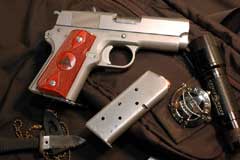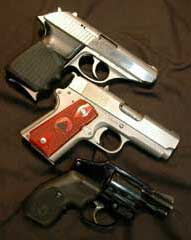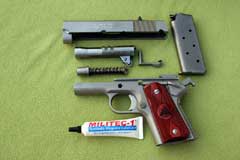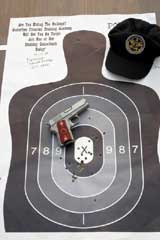|
Some
guns you just never quite forget and that applies to the Detonics
Combat Master .45 ACP semi-automatic pistol.
I have followed the “gun rags” from the days of my
youth and often haunted the gun shops looking for that new model
I saw in a firearms journal.
Such was the case when I was a youthful deputy sheriff in
1979 and walked into one of the local gun emporiums one day and
spied a small, bright metal pistol that resembled a scaled-down
1911 with a chunk missing out of the rear of the slide.
Wow, a Detonics Combat Master!
Of course I had seen pictures in magazines, but here was
one for real, a miniaturized .45 auto with all the “bells and
whistles” right from the factory.
It was about the same size as the Smith & Wesson
Model 36 I had that moment riding under my loose-fitting
Hawaiian shirt, but was all stainless steel and carried seven
big .45 caliber cartridges as opposed to the 5 .38 Special
rounds in my little Chief’s Special.
I checked it out and tried to think of ways to justify
the purchase to my new wife (like I could afford it anyway), but
the reality was, it went back in the case and I went home.
About 10 years later the Combat Master went out of
production and I never did get to add one to my battery.
Now
here it is 2006, and I have a brand new Detonics Combat Master,
almost exactly like the one I fondled over 25 years ago.
Resurrected as Detonics USA, the company president
is Jerry Ahern, which some of you will recognize as a gun
scribe and author of THE SURVIVALIST series of paperback
novels. Jerry was
very much into Detonics pistols back then and the hero of his
books, John Rourke, carried a brace of stainless Detonics
pistols during his escapades.
This mini-1911 was also a hit in Hollywood and appeared
on movies like Terminator 2 and TV shows like Miami
Vice. The
Detonics Combat Master was truly radical back in those days when
your typical 1911 was a full-size Colt Government Model
or slightly smaller Commander.
To get the standard features found on the Combat Master
added to your Colt usually required a trip to a custom pistol
smith accompanied by the added expense and requisite wait for
the work to be completed. Here
was a factory pistol with a “reverse cone” type barrel that
required no bushing, 3-dot combat sights, lowered ejection port,
concentric recoil spring with a guide rod, chopped hammer spur,
plus a shortened and deactivated grip safety.
Plus it was a pioneer stainless steel self-loader in the
days when stainless steel guns were plagued with “galling”
that interfered with reliable functioning.
Besides
the size, the thing that got the most notice was the “chunk”
taken out of the upper-rear surface of the slide.
This gently sloping surface was meant to facilitate
thumb-cocking of the weapon as it allowed more exposure for the
stubby hammer spur. The
inch or so that this decreased from the sight radius had little
effect on what was essentially a “belly gun” designed to be
carried concealed and used “up close and personal.”
Of course if one wished to do so the pistol could be
carried in “Condition One” as Col. Cooper calls it
with a round in the chamber, the hammer cocked and the safety
applied. Personally, that is the way I would carry this pistol as I
find it too difficult to cock with the shooting hand and
although it is pretty fast if you cock it with the support hand
thumb, it also mandates that you use both hands.
It could be that the support hand is out of action or
occupied fending off a knife strike.
The
re-issue of the Detonics Combat Master looks very much like the
vintage model form the late 1970’s, the most obvious
difference being the new model does not have the 3 white dots on
the sights. Instead
the sights on the test model were very robust, the front blade a
full 1/8” wide and serrated, while the rear sight notch
allowed plenty of light to be seen on both side of the front
sight. Both sights
are mounted in dovetail cuts in the slide and can be moved right
or left for windage adjustment.
My sample was well put together with obvious care in the
fit and finish of the pistol.
The matte stainless steel was attractive and
non-reflective as befits a combat weapon and I could find no
external flaws. The
6-round magazine is also matte stainless and when fully loaded a
small tab projects from the bottom rear of the floor plate.
The attractive grip panels (also a departure from the
original design) are made of rosewood and have a traditional
diamond pattern at the grip screws and the Detonics logo within
a circle in the center, all of which is surrounded by cut
checkering.
The
Detonics Combat Master comes with a flat mainspring housing
which is deeply serrated and mates right into what would be the
grip safety on a standard 1911, but on the Detonics is
deactivated and reduced in size with a rounded rear surface.
I was concerned that there might be some hammer bite when
firing this gun, but the cut-down “Commander” hammer-spur
never touched the web of my hand.
The trigger has an over-travel adjustment screw on the
face and is serrated, but is otherwise fairly standard with a
pull weight of around 5 pounds with the usual take-up found on
the 1911-style handguns. This
gun also has the standard commercial type safety lever, slide
release lever and magazine release button, which reduces the
things that might catch on clothing during a rapid draw.
Other features include a beveled magazine well, a
heavy-duty firing pin spring, and the slide contains a brawny
“torsion spring” internal extractor for positive ejection of
empty cartridge cases, especially with the lowered and beveled
ejection port. Of
course the top of the magazine well and barrel throat are mirror
polished for reliable feeding of ammunition.
Each gun comes in a lockable, black plastic case with a
foam-rubber lining, a gun lock, owners manual and a small tube
of Militec-1 synthetic weapons lubricant.
The
disassembly drill with the Detonics Combat Master is a bit
different than on the 1911 due to the fact that it does not have
a barrel bushing that must be removed and the recoil cap
attached with a screw into the guide rod on which the multiple,
concentric recoil springs ride.
I won’t belabor you with the disassembly details here,
but suffice to say if you buy one of these guns then be sure to
RTFM for the proper take-down instructions and other pertinent
information. One
thing Detonics likes to “crow” about in their literature is
the fact that all parts on the Detonics pistols are manufactured
from the highest quality stainless steel, with no metal
injection molded or plastic parts, and each and every gun is
produced right here in the USA!
The factory has very high standards and even included a
test target affirming the accuracy of the handgun.
Now
for the shooting. I had brought this sample Detonics Combat Master with me to
the 2005 Shootists Holiday at the NRA Whittington
Center in Raton, New Mexico, with the avowed purpose of
giving it a good “wringing out.”
I went through my ammo locker and pulled out every box of
factory cartridges marked with a big blue ‘P’ which
signifies to me that it is a partial box.
A number of these were in .45 ACP and earmarked for use
in testing the Detonics reliability.
I had 3 factory magazines, so I was able to keep up a
barrage while shooting on the Hunter Pistol animal silhouette
target range. When
I did my part, the steel Javelina targets at 50 meters were no
match for the mini .45 and I only had a few “hiccups” with
some Cor-Bon loads that featured a sharp-nosed, truncated
HP bullet, which sometimes caused a failure to feed.
None of the more rounded JHP cartridges posed any
problems in the little handgun.
With
the Detonics “loosened-up” a bit, it was time to do some
paper-punching. Out
of all the .45 ACP ammo I had on hand I selected some 230 gr.
“Ball” from Black
Hills, 230 gr. JHP +P from Cor-Bon, 200 gr. JHP +P moly-coated
cartridges from Norma, 185 gr. JHP by Federal, and
155 gr. frangible bullet loads from International Cartridge
Corporation. My
first order of business was to see what kind of velocities I
would get out of the 3-1/2” barrel on the Detonics pistol.
Five rounds of each ammo brand were fired over my Oehler
Model 35P chronograph to obtain an average velocity.
Next, I put up targets at a distance of 30 feet and did
some accuracy testing using a bench rest and sandbag.
My best 5-shot group measured 1.16” and was made using
the Black Hills “Ball” ammo, which I am told is used by
Detonics to test shoot their handguns. A very close second place went to the International Frangible
loads with a cluster measuring 1.17” and the third spot went
to Federal, with my dial calipers giving a group measurement of
1.48.” Group averages for all the test loads, velocity and muzzle
energy figures are shown in the chart below:
Detonics
Combat Master .45 ACP Performance Table
| Cartridge |
Average Velocity (FPS) |
Muzzle Energy (FPE) |
Group Average (inches) |
| Black Hills 230 gr. FMJ |
739 |
278 |
2.28" |
| Cor-Bon 230 gr. JHP +P |
836 |
357 |
2.59" |
| Federal 185 gr. JHP |
848 |
295 |
1.99" |
| International 155 gr. Frangible |
1054 |
458 |
2.32" |
| Norma 200 gr. JHP +P Moly |
927 |
381 |
2.66" |
NOTE:
Velocities average 5 rounds over Oehler Model 35P
chronograph; group average of four 5-shot groups at 30’ from a
rest. FPE (Ft. Lbs.
Energy) FPS (Feet per Second) FMJ (Full Metal Jacket) JHP
(Jacketed Hollow Point).
Some
practical shooting was done using B-27 type silhouette targets
and a 30-round combat qualification course I shoot regularly on
the job. I strapped
on a Bianchi Black Widow holster and loaded up my
magazines with the International cartridges.
Shooting was done at 3, then 7 and 15 yards, using a
variety of exercises such as strong hand only firing, double
taps, body armor drill, and barricade usage.
The Detonics Combat Master performed exceptionally and
although this is not the target I use for qualifications, I
scored a 292/10X out of 300 possible points, giving myself 10
points for the two head shots.
There were no malfunctions during the course and all
magazines ejected with aplomb during the mandatory combat
reloads. Those big, chunky sights were easy to pick up for fast repeat
shots at 7 and 15 yards where their use was allowed.
One
thing I did note was that sharp edge on the bottom rear of the
butt caused by the flat mainspring housing.
After a lot of fast shooting it tends to gouge the palm a
bit, and a rounded edge would make extended shooting sessions
more comfortable if you are not using shooting gloves. The heavy-duty recoil spring can also cause problems for
weaker shooters when they have to retract the slide, however,
there is a good article on the Detonics web site that addresses
that and is a “must read.”
The Militec-1 lubricant was used exclusively and it kept
the Combat Master perking along famously.
If
your needs and desires point towards a compact 1911-type pistol
then I would recommend the Detonics Combat Master to your
attention. The
factory literature points out and I agree that it is…”not a
bargain alternative to the traditional 1911-style
semi-automatic, Detonics is the logical refinement.”
William
Bell
Detonics Combat Master Specifications
 |
Semi-automatic 1911-type compact pistol |
|
|
 |
Chambered for .45 ACP (also available in
9mm, .357 SIG, .40 S&W) |
|
|
 |
6+1 capacity (.45) |
|
|
 |
All stainless steel construction, matte
finish |
|
|
 |
Checkered rosewood gr
ip panels |
|
|
 |
Empty weight 32 oz. |
|
|
 |
Overall Length 6-7/8” |
|
|
 |
Width 1-1/4” |
|
|
 |
Height from top of slide to lowest
position on grip
4-7/16” |
|
|
 |
Fixed sights, windage adjustable |
|
|
 |
Manual safety lever w/ deactivated grip
safety |
|
|
 |
MSRP $1200 |
Product Information
Detonics USA LLC
115 Enterprise Dr., Suite B
Pendergrass, GA 30567
866-759-1169
www.detonicsusa.com
Bianchi International (Black Widow Holster)
27969 Jefferson Ave.
Temecula, CA 92590
800-477-8545
www.bianchi-intl.com
MILITEC, Inc. (Militec-1 Lubricant)
11828 Pika Dr.
Waldorf, MD 20602
877-222-5512
www.militec-1.com
  
Got something to say about this article? Want to agree (or
disagree) with it? Click the following link to go to the GUNBlast Feedback Page.
|
|
Click pictures for a larger version.

The Detonics Combat Master was the first
of the factory mini-1911’s when it was introduced in 1979.
It was set up as a concealed-carry gun for cops and
legally armed citizens, offering 7 rounds of .45 ACP power in
a small package. (Photo
by Doug Taylor)

Although a full-caliber .45 semi-automatic, the Combat
Master was closer in size to smaller caliber handguns like the
SIG P-230 and the Smith & Wesson M-42 seen above and below
it. (Photo by Doug
Taylor)

Disassembled,
you can see the barrel and recoil spring/guide, which were two
items that made this such an innovative pistol when it was
introduced. The
Militec-1 lubricant was furnish by the factory with the test
pistol. (Author Photo)

In
the foreground you can see the 5 brands of .45 ACP ammo the
author used to test the Detonics Combat Master.
In the background, the Combat Master rides in a Bianchi
Black Widow holster. (Author
Photo)

These
bulls-eye targets were shot from a distance of 30 feet using
the Combat Master and the test ammo.
Bench rest accuracy was more than sufficient for use in
the field as these groups illustrate.
(Author Photo)

The
Combat Master proved itself more than capable during the
combat shooting phase of the evaluation.
Ranges went from 3-15 yards and included several
shooting stances; the author scored a 292/10X out of 300
possible on this target. (Author
Photo) |
![]()